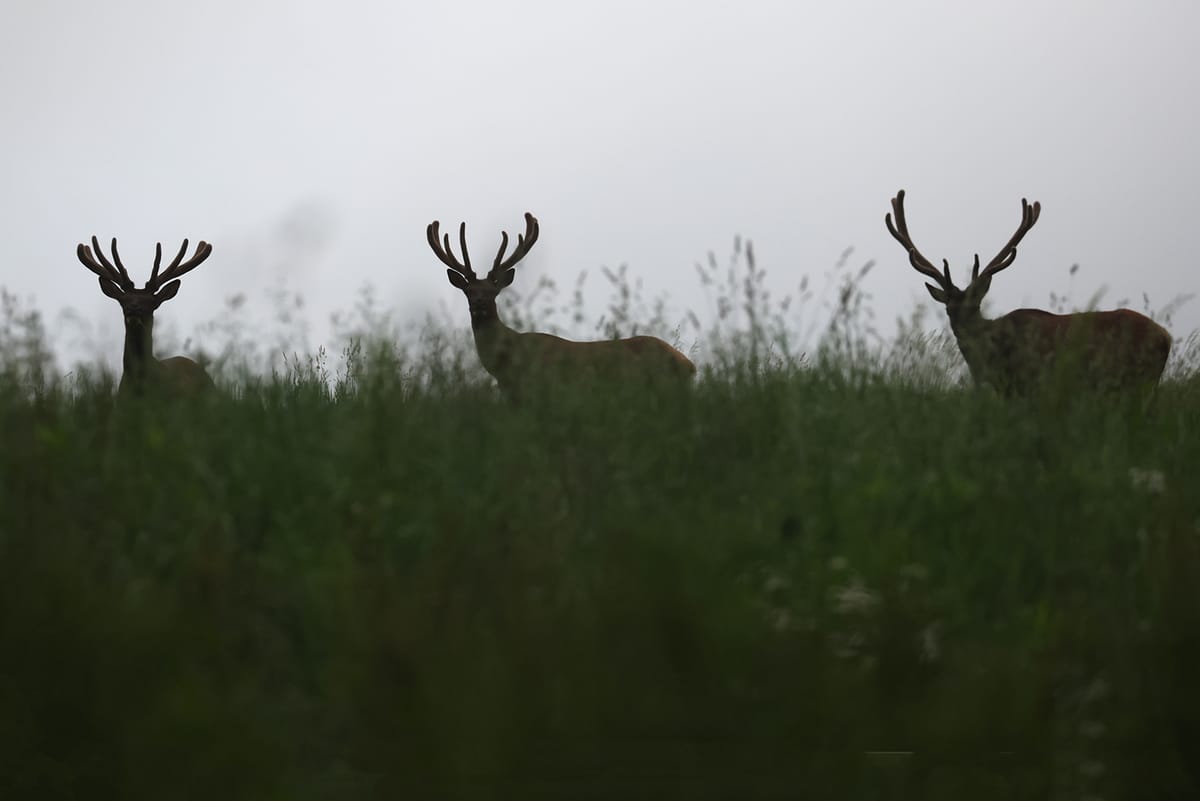Wandering Aimlessly - Bands of Brothers

It was 6:30 a.m. the first day of summer, Friday, June 20, and I was out looking for something to shoot. Mary and I had been seeing a group of three bulls on Moore Hill, and as I approached the cemetery, I saw them grazing in a field about 100 yards off the road. I picked out an opening in the trees that lined the road and commenced firing.
I had taken shots of these bulls the week before, but with a long lens, the depth of field (the area in the shot that is in critical focus) is very shallow. The bulls were close together, but their distances to me varied, and I couldn’t get them all in focus. On this morning of June 20, the bulls were perfectly lined up broadside, all the same exact distance away, and silhouetted in the skyline—perfect!
The bulls were developing into trophy bulls and already had at least five points on each antler. At the end of July, they will all be 6x6 or 7x7 bulls, and by September these summer buddies will become rivals and enter into horn rattling conflicts for the favor of the ladies.
Bull elk will add inches of growth throughout July, and by the end of July their antlers will begin hardening. Early in August they will shed their velvet, which marks the onset of the rut. At this time, their “buddy” status suddenly disappears!
If you are out cruising on wandering aimlessly adventures looking for bull elk, we have been seeing bands of these boys of summer on Moore Hill, Gray Hill, and Huston Hill. I also note some online shots of a huge bull that already has nine or 10 points on each antler that has now shown up on Winslow Hill.
It has been extremely hot, and these large critters don’t like heat, so cruise at dawn or at dusk.
You be careful out there!
***
One den area I hiked to I had not visited in about 10 years, and all I found was one large, freshly-shed snakeskin. There are about a dozen large rocks in this area, and I usually find around a dozen rattlesnakes out basking on the rocks at 9:00 in the morning.
When I arrived at the den, which I had difficulty locating, I was very dismayed. The hillside had been an open area but was now overgrown with saplings that shaded the rocks. If I were younger, I would have walked the ridgeline searching for rocks in more open areas that the snakes might have moved to. I headed back to the Subaru and would try a different basking area later.
The morning wasn’t a total loss because I found some Indian pipes peeking up through the leaves in some decaying vegetation. Indian pipes are unique flowering plants that lack chlorophyll. They are white to a pale shade of pink, and many neophytes think they are fungus.
They were growing in a shaded area, and rather than relying on sunlight, Indian pipes obtain nutrients by parasitizing fungi within trees. Ultimately, Indian pipes derive their energy from the photosynthesis occurring in nearby trees.
Indian pipes usually have some black flecks on their white stems and a cool nodding flower which turns upward as it matures. Indian pipe is native to our area and is so named because the plant resembles an Indian peace pipe. Enjoy their beauty if you stumble on them, but leave them alone because they contain glycosides.
In Native American cultures, Indian pipes were believed to carry the souls of the departed, and some tribes viewed the plant as a symbol of peace and a connection to the spiritual world.
As I was passing through an old field, I noticed some tiger swallowtail butterflies feeding on milkweed blossoms. I wandered over to these plants, and the butterflies were calm and unalarmed by my presence.
Tiger swallowtails are large yellow and black butterflies. An online source said the butterflies only live for two weeks and that their entire life cycle lasts about two months. They emerge in late April and June after wintering in the chrysalis. The caterpillar that emerges is black with a white band around the middle.
***
Last week’s question asked if cicadas and locusts are the same insect. The answer is no. They are different types of insects belonging to different orders.
Your new question concerns the white Indian pipes I photographed last week. Indian pipes also go by another common name relating to their lack of chlorophyll. What is the other common name for Indian pipe? If you need a clue, think Casper!
By Phil Burkhouse

